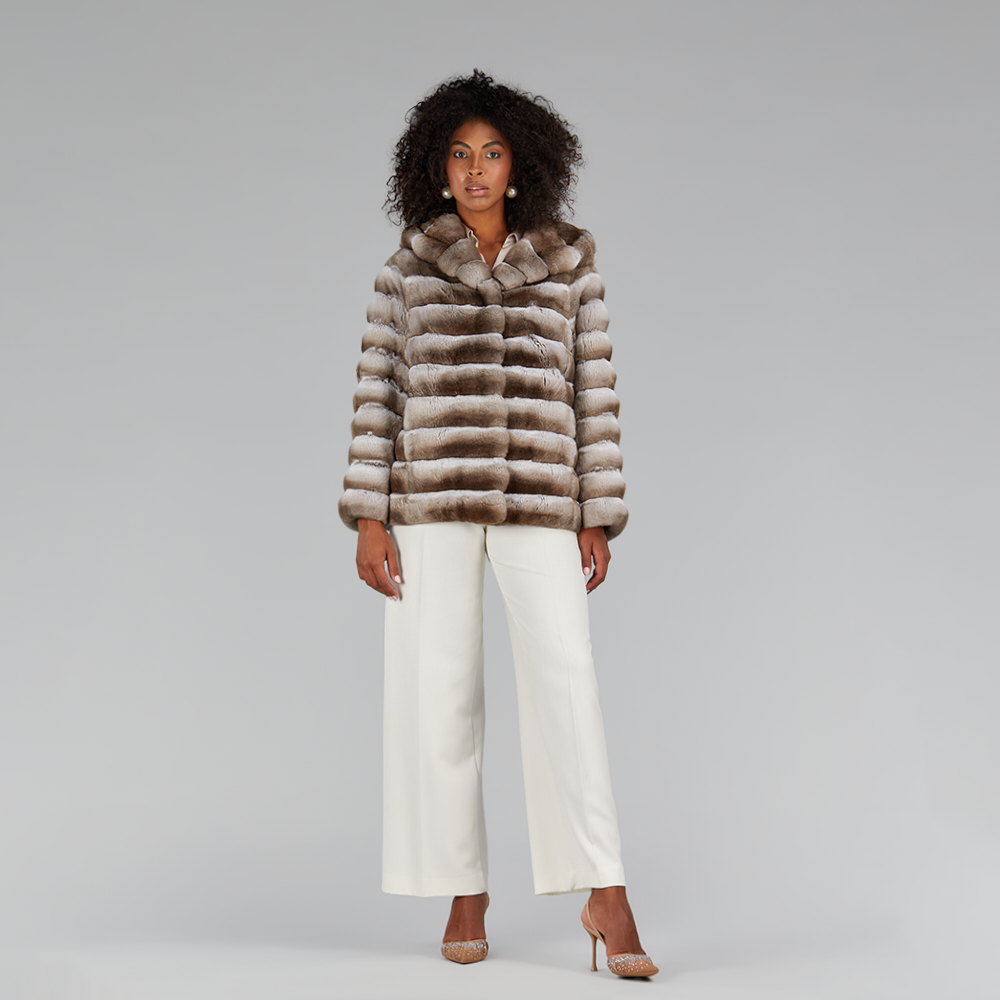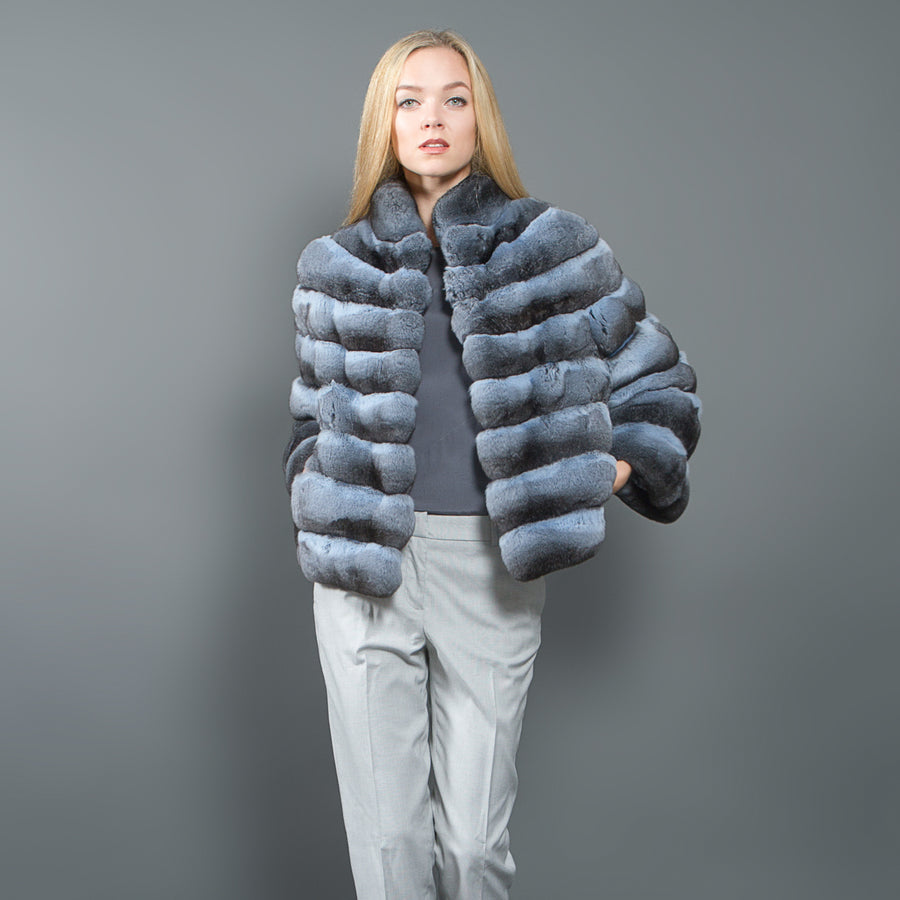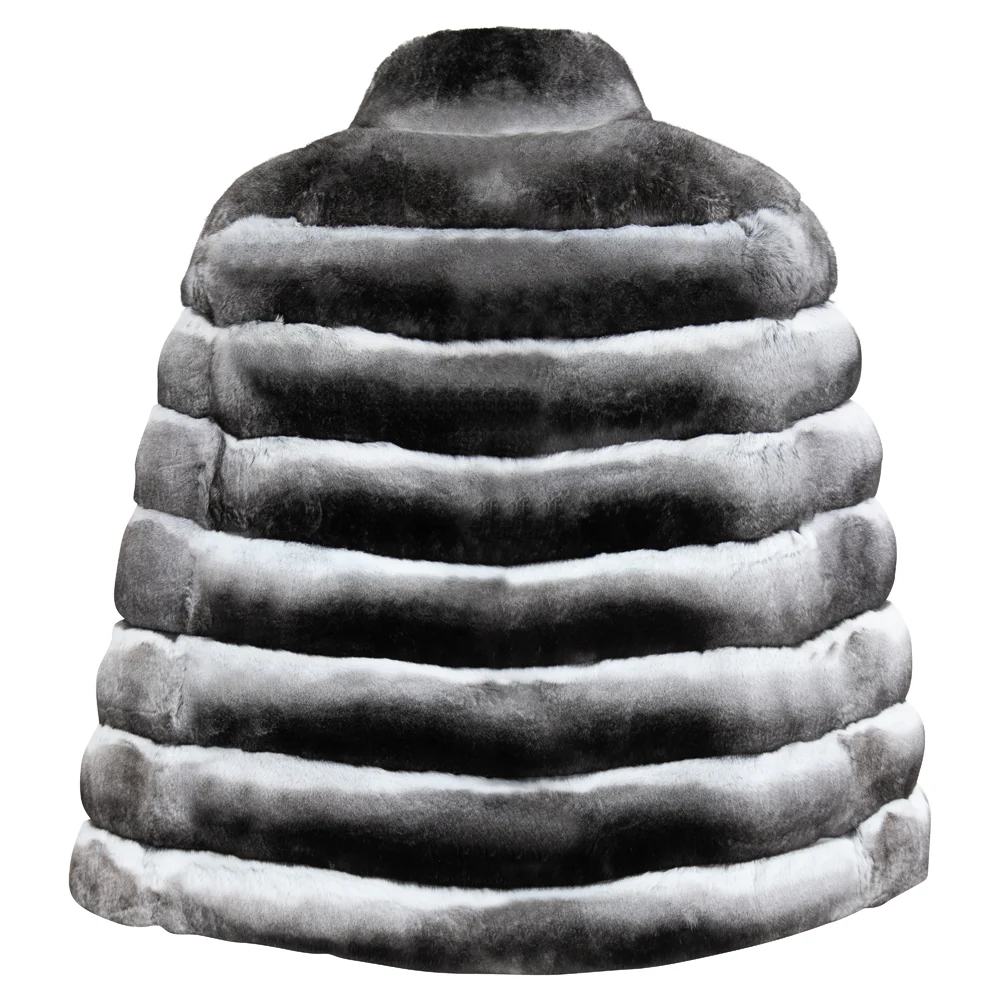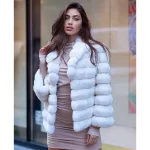The Unique Qualities of Chinchilla Fur
Chinchilla fur coat! Chinchilla fur is known for its remarkable softness and density. Unlike other furs, chinchilla fur consists of more than 50 fine hairs growing from a single follicle. This unique feature gives it an exceptional plush feel that many find luxurious. The fur’s dense nature also provides unparalleled warmth, making it highly sought after in cold climates.

Another distinctive quality of chinchilla fur is its color. The natural grey hue with subtle white highlights creates an elegant and timeless look. This fur reflects light in a way that adds depth and sophistication to the coat’s appearance.
Chinchilla fur is also highly durable when properly cared for. With the right maintenance techniques, a chinchilla fur coat can retain its beauty and functionality for years. This resilience adds value to the fur coat, making it not only a fashionable choice but also an investment.
However, because of these unique qualities, chinchilla fur requires specific care and handling. Owners must be aware of the delicate nature of the fur and follow proper storage, cleaning, and maintenance routines to preserve its unique characteristics. In the following sections, we will explore how to properly care for your chinchilla fur coat, ensuring it stays as soft, luxurious, and beautiful as the day you acquired it.
Proper Storage for Chinchilla Coats
Storing your chinchilla fur coat correctly is critical to its longevity. Here are some best practices.
Keep It Cool and Dry: Store the coat in a cool, dry place. Avoid areas where heat or humidity is high, as they can damage the fur.
Use a Cloth Garment Bag: A breathable cloth garment bag will protect the fur from dust and light. Steer clear of plastic, as it can prevent air circulation.
Avoid Compression: Hang the coat on a broad-shouldered, padded hanger. This prevents creases and ensures the fur does not get crushed.
Leave Space in Closet: Make sure there’s enough room in your closet. The fur needs space to hang freely without getting squeezed against other items.
By following these simple steps, you ensure your chinchilla fur coat remains in pristine condition when not in use. Proper storage is the first step in maintaining the luxurious appeal of your investment.
Routine Cleaning and Maintenance
Maintaining the condition of a chinchilla fur coat involves regular care. To effectively clean and keep up your coat, observe these guidelines:
Brush Regularly: Use a soft-bristled brush. Gently brush the fur to remove dust and debris. This keeps the fur silky.
Spot Clean Spills Immediately: Blot spills with a clean, dry cloth. Do not rub as this can mat the fur.
Air It Out: Sometimes, just airing out your coat can refresh it. Avoid direct sunlight, which can fade the fur.
Avoid Chemicals: Don’t apply perfumes or hairsprays directly onto the coat, as chemicals can harm the fur.
Keep It Dry: If your chinchilla fur coat gets wet, shake off excess water. Then, let it dry naturally, away from heat sources.
Following these tips helps maintain your coat’s softness and luster. Incorporating them into your routine ensures that your chinchilla fur coat remains a luxurious item in your wardrobe.

Professional Fur Care and When to Seek It
Professional care can ensure your chinchilla fur coat stays in top condition. Some scenarios call for expert assistance. If your coat suffers damage or needs a deep clean, professionals have the right tools and experience. They can handle extensive repairs, like tears or fur replacement, with skill. Additionally, they offer deep cleaning processes that are too delicate or complex for at-home methods.
Seek professional help if:
- After Stains or Spills: If spills set in or stains are stubborn, experts can help.
- For Annual Cleaning: A yearly visit to a fur specialist can preserve your coat’s quality.
- When Dealing with Odors: Professionals can remove odors without harming the fur.
- Before Long-Term Storage: They can prepare your coat for storage accurately.
- If the Coating Gets Wet: Beyond a simple dry out, they can restore the coat’s feel and look.
Using professional services helps maintain the coat’s luxurious feel, ensuring your chinchilla fur coat remains beautiful for years.
Dealing with Wrinkles and Creases
Even with careful storage, your chinchilla fur coat may develop wrinkles and creases. It’s important to address these issues gently to keep the fur in top condition. Here are some simple but effective methods for dealing with wrinkles and creases in your chinchilla fur coat:
Hang the Coat Properly: Simply hanging your coat on a broad, padded hanger overnight can help reduce minor wrinkles.
Use Steam Carefully: If hanging doesn’t remove the wrinkles, you can use steam. Hang the coat in a steamy bathroom for a short period. Don’t let it get wet.
Trust Professionals for Ironing: Never attempt to iron the fur at home. If wrinkles persist, take your coat to a fur specialist. They can use professional equipment to safely remove wrinkles without harming the fur.
Remember, excessive handling or incorrect treatment can damage the delicate chinchilla fur. When in doubt, always opt for professional assistance to maintain the coat’s luxurious appearance.
Protecting Your Fur Coat from Pests
Pests can cause serious damage to your chinchilla fur coat if not properly guarded against. Moths and beetles are common culprits that eat through fur, leaving behind holes and a coat beyond repair. Preventing these pests from reaching your precious garment is key. Here are effective strategies to keep pests at bay:
Use Cedar Blocks or Lavender Bags: These natural repellents can ward off moths and beetles. Place them in your closet or the storage space where you keep your fur coat.
Regular Inspection: Check your coat often, especially if stored for long periods. Look for any signs of pest activity, such as larvae or webbing.
Clean Before Storage: Pests are attracted to dirt and natural oils. Make sure your coat is clean before storing it. Consider professional cleaning for best results.
Avoid Mothballs: While mothballs can deter pests, they contain chemicals that might damage the fur over time. Opt for safer alternatives like those mentioned above.
By implementing these simple measures, you can protect the luxurious quality of your chinchilla fur coat from unwanted guests. Regular vigilance and proper storage habits are your best defenses against pests.

Insurance and Appraisal for Chinchilla Fur
Owning a chinchilla fur coat is a notable investment. To protect this asset, insurance and appraisal are key steps. Here are reasons and strategies to ensure you cover your valuable chinchilla fur coat adequately.
Get It Appraised: Know the value of your coat through a professional appraisal. This confirms its worth and helps set the right insurance coverage amount.
Document Your Coat: Keep a record of purchase receipts, appraisals, and any maintenance history. These documents are crucial for insurance claims.
Choose the Right Insurance: Look for a policy that covers theft, loss, and damage. A specialized fur coat insurance is ideal.
Update Coverage Regularly: As the value of your chinchilla fur coat may change, update your insurance accordingly. Reappraise the coat every few years.
By taking these steps, you can safeguard your chinchilla fur coat financially. Theft, damage, or loss will be less stressful with the right insurance in place.
Ethical Considerations and Alternatives
When considering a chinchilla fur coat, it’s vital to remember the ethical implications. The production of animal fur coats often involves practices that raise concerns for animal welfare advocates. Due to this, some people opt for alternatives that do not harm animals.
Consider the Source: Gain knowledge about where and how the chinchilla fur was sourced. Look for furriers who follow ethical and humane standards.
Synthetic Options: Explore faux fur options. High-quality synthetic furs can offer the plush feel of chinchilla without using animal fur.
Vintage Coats: Choose a vintage chinchilla fur coat. This reduces demand for new fur products and promotes sustainable fashion.
Support Legislation: Encourage and support laws that ensure the ethical treatment of animals. By doing so, we promote a more humane fur industry.
Educate Yourself and Others: Learn about the fur industry. Share information to make others aware of the ethical concerns.
By making informed decisions, you can enjoy the luxury of fur while considering the well-being of animals. Alternatives to new fur coats are available, giving consumers choices that align with their values.


